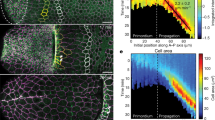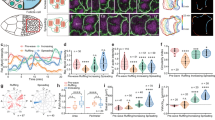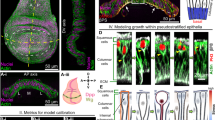Abstract
Drosophila germ-band extension (GBE) is an example of the convergence and extension movements that elongate and narrow embryonic tissues. To understand the collective cell behaviours underlying tissue morphogenesis, we have continuously quantified cell intercalation and cell shape change during GBE. We show that the fast, early phase of GBE depends on cell shape change in addition to cell intercalation. In antero-posterior patterning mutants such as those for the gap gene Krüppel, defective polarized cell intercalation is compensated for by an increase in antero-posterior cell elongation, such that the initial rate of extension remains the same. Spatio-temporal patterns of cell behaviours indicate that an antero-posterior tensile force deforms the germ band, causing the cells to change shape passively. The rate of antero-posterior cell elongation is reduced in twist mutant embryos, which lack mesoderm. We propose that cell shape change contributing to germ-band extension is a passive response to mechanical forces caused by the invaginating mesoderm.
This is a preview of subscription content, access via your institution
Access options
Subscribe to this journal
Receive 12 print issues and online access
$209.00 per year
only $17.42 per issue
Buy this article
- Purchase on Springer Link
- Instant access to full article PDF
Prices may be subject to local taxes which are calculated during checkout




Similar content being viewed by others
References
Glickman, N. S., Kimmel, C. B., Jones, M. A. & Adams, R. J. Shaping the zebrafish notochord. Development 130, 873–887 (2003).
Keller, R. Mechanisms of elongation in embryogenesis. Development 133, 2291–2302 (2006).
Solnica-Krezel, L. Conserved patterns of cell movements during vertebrate gastrulation. Curr. Biol. 15, R213–R228 (2005).
Munro, E. M. & Odell, G. M. Polarized basolateral cell motility underlies invagination and convergent extension of the ascidian notochord. Development 129, 13–24 (2002).
Costa, M., Sweeton, D. & Wieschaus, E. Gastrulation in Drosophila: Cellular mechanisms of morphogenetic movements in The development of Drosophila melanogaster (eds. Bate, M. & Martinez-Arias, A.) 425–465 (Cold Spring Harbor Laboratory Press, 1993).
Bertet, C., Sulak, L. & Lecuit, T. Myosin-dependent junction remodelling controls planar cell intercalation and axis elongation. Nature 429, 667–671 (2004).
Blankenship, J. T., Backovic, S. T., Sanny, J. S., Weitz, O. & Zallen, J. A. Multicellular rosette formation links planar cell polarity to tissue morphogenesis. Dev. Cell 11, 459–470 (2006).
Irvine, K. D. & Wieschaus, E. Cell intercalation during Drosophila germband extension and its regulation by pair-rule segmentation genes. Development 120, 827–841 (1994).
Zallen, J. A. & Wieschaus, E. Patterned gene expression directs bipolar planar polarity in Drosophila. Dev. Cell 6, 343–355 (2004).
da Silva, S. M. & Vincent, J. P. Oriented cell divisions in the extending germband of Drosophila. Development 134, 3049–3054 (2007).
Oda, H. & Tsukita, S. Real-time imaging of cell–cell adherens junctions reveals that Drosophila mesoderm invagination begins with two phases of apical constriction of cells. J. Cell Sci. 114, 493–501 (2001).
Blanchard, G. B. et al. Tissue tectonics: morphogenetic strain rates, cell shape change and intercalation. Nature Methods 6, 458–464 (2009).
Hartenstein, V. & Campos-Ortega, J. A. Fate-mapping in wild-type Drosophila melanogaster. 1. The spatio-temporal pattern of embryonic cell divisions. Roux' Arch. Dev. Biol. 194, 181–195 (1985).
Keller, R., Shook, D. & Skoglund, P. The forces that shape embryos: physical aspects of convergent extension by cell intercalation. Phys. Biol. 5, 15007 (2008).
Vincent, A., Blankenship, J. T. & Wieschaus, E. Integration of the head and trunk segmentation systems controls cephalic furrow formation in Drosophila. Development 124, 3747–3754 (1997).
Weaire, D. & Hutzler, S. The Physics of Foams (Oxford Univ. Press, 2001).
Leptin, M. & Grunewald, B. Cell shape changes during gastrulation in Drosophila. Development 110, 73–84 (1990).
Seher, T. C., Narasimha, M., Vogelsang, E. & Leptin, M. Analysis and reconstitution of the genetic cascade controlling early mesoderm morphogenesis in the Drosophila embryo. Mech. Dev. 124, 167–179 (2007).
Sweeton, D., Parks, S., Costa, M. & Wieschaus, E. Gastrulation in Drosophila: the formation of the ventral furrow and posterior midgut invaginations. Development 112, 775–789 (1991).
Kam, Z., Minden, J. S., Agard, D. A., Sedat, J. W. & Leptin, M. Drosophila gastrulation: analysis of cell shape changes in living embryos by three-dimensional fluorescence microscopy. Development 112, 365–370 (1991).
Pouille, P. A. & Farge, E. Hydrodynamic simulation of multicellular embryo invagination. Phys. Biol. 5, 15005 (2008).
Leptin, M. twist and snail as positive and negative regulators during Drosophila mesoderm development. Genes Dev. 5, 1568–1576 (1991).
Thisse, B., Stoetzel, C., Gorostiza-Thisse, C. & Perrin-Schmitt, F. Sequence of the twist gene and nuclear localization of its protein in endomesodermal cells of early Drosophila embryos. EMBO J. 7, 2175–2183 (1988).
Pope, K. L. & Harris, T. J. Control of cell flattening and junctional remodeling during squamous epithelial morphogenesis in Drosophila. Development 135, 2227–2238 (2008).
Keller, R., Shih, J. & Sater, A. The cellular basis of the convergence and extension of the Xenopus neural plate. Dev. Dyn. 193, 199–217 (1992).
Keller, R. E. & Trinkaus, J. P. Rearrangement of enveloping layer cells without disruption of the epithelial permeability barrier as a factor in Fundulus epiboly. Dev. Biol. 120, 12–24 (1987).
Weliky, M. & Oster, G. The mechanical basis of cell rearrangement. I. Epithelial morphogenesis during Fundulus epiboly. Development 109, 373–386 (1990).
Casso, D., Ramirez-Weber, F. A. & Kornberg, T. B. GFP-tagged balancer chromosomes for Drosophila melanogaster. Mech. Dev. 88, 229–232 (1999).
Pinheiro, J. C. & Bates, D. M. Mixed-effects Models in S and S-PLUS (Springer, 2000).
R Research Development Team. R: A language and environment for statistical computing. (R Foundation for Statistical Computing, 2008).
Wickham, H. ggplot2: an implementation of the grammar of graphics. R package version 0.8.1 (Springer, 2008).
Acknowledgements
We thank Claire Lye, Bruno Monier and Daniel St Johnston for comments on the manuscript and discussions. We thank the Bloomington Drosophila Stock Centre for fly strains. This work was supported by a Human Frontier Science Program grant to B.S., a Wellcome Trust studentship to L.C.B., a Medical Research Council grant to R.J.A. and a Harvard–National Science Foundation Materials Research Science and Engineering Center award to M.L.
Author information
Authors and Affiliations
Contributions
This project grew from a close collaboration between the groups of B.S. and R.J.A. L.C.B. performed the experiments and analysed the data with G.B.B., R.J.A. and B.S. N.J.L. performed the initial experiments and developed the time-lapse methods. D.P.W. contributed to experiments and manuscript preparation. Strain rate analyses were developed by G.B.B., A.J.K., R.J.A. and L.M., building on a tracking and quantification framework of G.B.B. and R.J.A. B.S. and L.C.B. designed the Drosophila experiments and prepared the manuscript. All authors contributed to data interpretation and editing of the manuscript.
Corresponding author
Ethics declarations
Competing interests
The authors declare no competing financial interests.
Supplementary information
Supplementary Information
Supplementary Information (PDF 1212 kb)
Supplementary Information
Supplementary Movie 1 (MOV 285 kb)
Supplementary Information
Supplementary Movie 2 (MOV 9257 kb)
Supplementary Information
Supplementary Movie 3 (MOV 8750 kb)
Supplementary Information
Supplementary Movie 4 (MOV 5891 kb)
Supplementary Information
Supplementary Movie 5 (MOV 6118 kb)
Supplementary Information
Supplementary Movie 6 (MOV 4461 kb)
Supplementary Information
Supplementary Movie 7 (MOV 6724 kb)
Supplementary Information
Supplementary Movie 8 (MOV 6739 kb)
Supplementary Information
Supplementary Movie 9 (MOV 4242 kb)
Supplementary Information
Supplementary Movie 10 (MOV 6993 kb)
Supplementary Information
Supplementary Movie 11 (MOV 6599 kb)
Supplementary Information
Supplementary Movie 12 (MOV 4188 kb)
Supplementary Information
Supplementary Movie 13 (MOV 6905 kb)
Supplementary Information
Supplementary Movie 14 (MOV 6488 kb)
Supplementary Information
Supplementary Movie 15 (MOV 4108 kb)
Supplementary Information
Supplementary Movie 16 (MOV 6942 kb)
Rights and permissions
About this article
Cite this article
Butler, L., Blanchard, G., Kabla, A. et al. Cell shape changes indicate a role for extrinsic tensile forces in Drosophila germ-band extension. Nat Cell Biol 11, 859–864 (2009). https://doi.org/10.1038/ncb1894
Received:
Accepted:
Published:
Issue Date:
DOI: https://doi.org/10.1038/ncb1894
This article is cited by
-
Extracting multiple surfaces from 3D microscopy images in complex biological tissues with the Zellige software tool
BMC Biology (2022)
-
Patterned mechanical feedback establishes a global myosin gradient
Nature Communications (2022)
-
Embryo-scale epithelial buckling forms a propagating furrow that initiates gastrulation
Nature Communications (2022)
-
A release-and-capture mechanism generates an essential non-centrosomal microtubule array during tube budding
Nature Communications (2021)
-
An Easy-to-Fabricate Cell Stretcher Reveals Density-Dependent Mechanical Regulation of Collective Cell Movements in Epithelia
Cellular and Molecular Bioengineering (2021)



